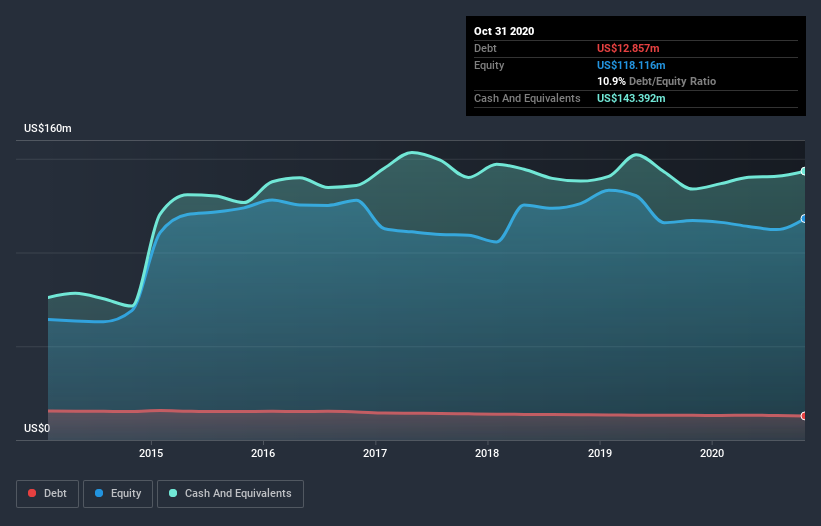These 4 Measures Indicate That QAD (NASDAQ:QADA) Is Using Debt Safely
Howard Marks put it nicely when he said that, rather than worrying about share price volatility, 'The possibility of permanent loss is the risk I worry about... and every practical investor I know worries about.' So it might be obvious that you need to consider debt, when you think about how risky any given stock is, because too much debt can sink a company. We note that QAD Inc. (NASDAQ:QADA) does have debt on its balance sheet. But should shareholders be worried about its use of debt?
When Is Debt Dangerous?
Debt is a tool to help businesses grow, but if a business is incapable of paying off its lenders, then it exists at their mercy. If things get really bad, the lenders can take control of the business. However, a more common (but still painful) scenario is that it has to raise new equity capital at a low price, thus permanently diluting shareholders. By replacing dilution, though, debt can be an extremely good tool for businesses that need capital to invest in growth at high rates of return. When we think about a company's use of debt, we first look at cash and debt together.
View our latest analysis for QAD
How Much Debt Does QAD Carry?
The chart below, which you can click on for greater detail, shows that QAD had US$12.9m in debt in October 2020; about the same as the year before. But on the other hand it also has US$143.4m in cash, leading to a US$130.5m net cash position.
How Healthy Is QAD's Balance Sheet?
According to the last reported balance sheet, QAD had liabilities of US$131.2m due within 12 months, and liabilities of US$35.6m due beyond 12 months. Offsetting these obligations, it had cash of US$143.4m as well as receivables valued at US$43.1m due within 12 months. So it actually has US$19.7m more liquid assets than total liabilities.
This state of affairs indicates that QAD's balance sheet looks quite solid, as its total liabilities are just about equal to its liquid assets. So while it's hard to imagine that the US$1.31b company is struggling for cash, we still think it's worth monitoring its balance sheet. Simply put, the fact that QAD has more cash than debt is arguably a good indication that it can manage its debt safely.
It was also good to see that despite losing money on the EBIT line last year, QAD turned things around in the last 12 months, delivering and EBIT of US$5.8m. When analysing debt levels, the balance sheet is the obvious place to start. But ultimately the future profitability of the business will decide if QAD can strengthen its balance sheet over time. So if you want to see what the professionals think, you might find this free report on analyst profit forecasts to be interesting.
But our final consideration is also important, because a company cannot pay debt with paper profits; it needs cold hard cash. QAD may have net cash on the balance sheet, but it is still interesting to look at how well the business converts its earnings before interest and tax (EBIT) to free cash flow, because that will influence both its need for, and its capacity to manage debt. Happily for any shareholders, QAD actually produced more free cash flow than EBIT over the last year. That sort of strong cash generation warms our hearts like a puppy in a bumblebee suit.
Summing up
While it is always sensible to investigate a company's debt, in this case QAD has US$130.5m in net cash and a decent-looking balance sheet. The cherry on top was that in converted 412% of that EBIT to free cash flow, bringing in US$24m. So we don't think QAD's use of debt is risky. When analysing debt levels, the balance sheet is the obvious place to start. But ultimately, every company can contain risks that exist outside of the balance sheet. Consider for instance, the ever-present spectre of investment risk. We've identified 2 warning signs with QAD , and understanding them should be part of your investment process.
If you're interested in investing in businesses that can grow profits without the burden of debt, then check out this free list of growing businesses that have net cash on the balance sheet.
This article by Simply Wall St is general in nature. It does not constitute a recommendation to buy or sell any stock, and does not take account of your objectives, or your financial situation. We aim to bring you long-term focused analysis driven by fundamental data. Note that our analysis may not factor in the latest price-sensitive company announcements or qualitative material. Simply Wall St has no position in any stocks mentioned.
Have feedback on this article? Concerned about the content? Get in touch with us directly. Alternatively, email editorial-team (at) simplywallst.com.

 Yahoo Finance
Yahoo Finance 
